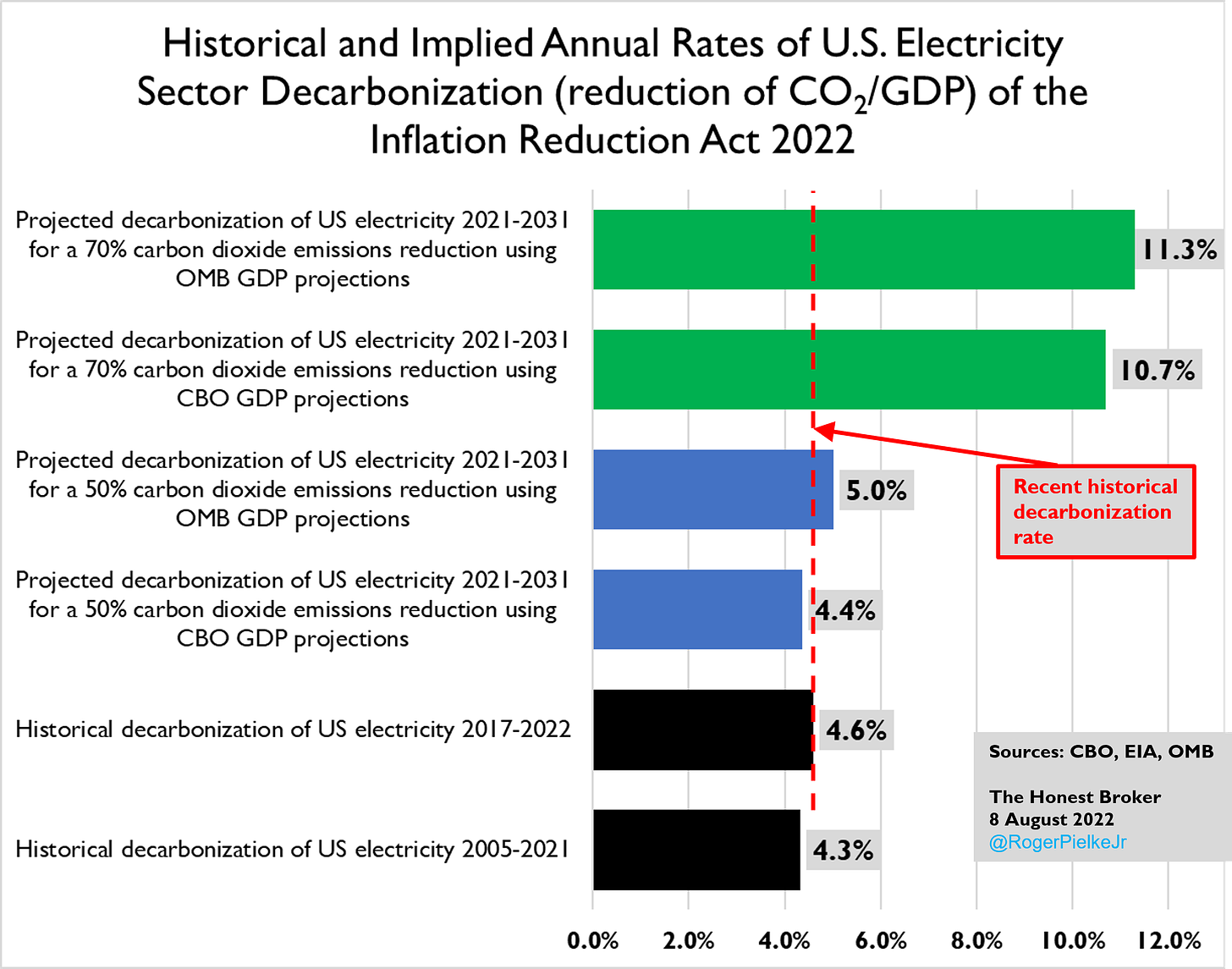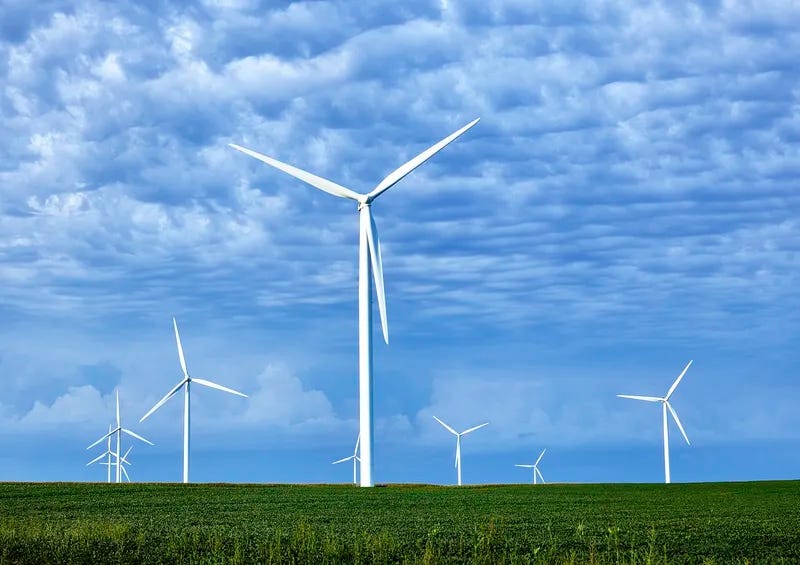How plausible are the emissions reduction promises of the Inflation Reduction Act?
A close look at implied decarbonization for the U.S. electricity sector
As I explain in my policy courses, the passing of legislation is only one step in a complicated process of turning policy proposals into policy outcomes. The Inflation Reduction Act of 2022 has not yet been signed into law, but after receiving approval yesterday by the Senate, that outcome looks close to certain.
In this post I share an initial analysis of the emissions reductions targets associated with the Inflation Reduction Act (IRA), which for the U.S. economy as a whole is advertised as a 40% reduction from 2005 levels. However, evaluating claims for future emissions reductions requires disaggregating across greenhouse gases and economic sectors. In this post I focus on implied decarbonization of the U.S. electricity sector.
More specifically, I focus is on implied rates of decarbonization associated with claims made by several architects and advocates of the bill. Three main consulting groups (REPEAT, Rhodium Group, and Energy Innovation) have contributed to writing the IRA, analyzing it for the media and promoting it in support of the bill’s passage. Each has published top-line estimates of the IRA’s effects on future emissions to 2030. Unfortunately, these analyses are not fully transparent, but there is enough information available for my decarbonization analysis.
So let’s get to it.
The focus here is decarbonization of the economy, which in technical terms is defined as a reduction in the ratio of carbon dioxide emissions to GDP. This is a common metric, if somewhat technical, and was a central focus on my book The Climate Fix. The decarbonization metric originates in the Kaya Identity and reflects the essential fact that emissions and economic activity are inter-related — Considering one without the other results in incomplete and possibly misleading analyses.
We can use recent decarbonization of the U.S. electricity sector to come up with a projection of the effects of current policies on future emissions. Using emissions data from the U.S. Energy Information Agency and GDP data from the Congressional Budget Office we can compute recent decarbonization rates as follows:
2005 to 2021 = 4.3% per year
2017 to 2021 = 4.6% per year
If we use 4.6% to project continuing rates of decarbonization to 2031, we arrive at a reduction of electricity carbon dioxide emissions from 1,551 million metric tonnes (Mmt) in 2021 to 969 Mmt in 2031. That is similar to the current policies projection of the Rhodium Group.
REPEAT projects that the IRA will result in an additional reduction in electricity emissions of 360 Mmt, taking emissions to 609 Mmt in 2031 (Note: REPEAT cites 2030, and I am using 2031 here, offering a bit more generous timing). The overall projected reduction in electricity emissions is thus >70% from 2005 (and ~60% from 2021), which is central to the projection of a 40% reduction in overall U.S. emissions by 2030. We thus have part of what we need to calculate implied decarbonization rates — projected emissions.
The second variable that we need is projected GDP. It turns out that the Congress and the White House project different futures for GDP growth — The White House is a bit more bullish. This is not surprising and has a political element to it (see our recent pre-print on over-optimism in such projections). So in the results below I use both CBO and White House (OMB) GDP projections.
The figure below shows the results:

The main takeaway of this analysis is that the implied rates of decarbonization of the U.S. electricity sector associated with the IRA are very, very aggressive. They reflect more that a doubling of recent rates, about 11% per year to 2031. That is a big number. The figure also shows with the blue bars decarbonization rates associated with a 50% reduction in electricity emissions, which is just about a business as usal decarbonization trajectory.
Note that my analysis is conservative in that I give 10 years for emissions reductions to occur (2021 to 2032). In reality, the timing is somewhat less (8 to 9 years) implying even greater rates of decarbonization.
Is is possible that U.S. electricity emissions decrease by 70% by 2031? Sure, it is possible.
Is it likely? No, in my view, not remotely.
Much more likely is that by 2030 emissions decline by more than 50% (business as usual) but less than 70%
Of course, after the failure of the Waxman-Markey climate bill more than a decade ago and the demise of the Obama-era Clean Power Plan, we saw actual emissions reduced by a greater amount than those projections used to promote those policies. However, I think the promises associated with the IRA err on the side of being far too optimistic. I have the same view of IRA-related projections of 2030 market penetration of electric vehicles and the deployment of carbon-capture technologies.
If the IRA emissions-reductions projections are indeed oversold, then it will be interesting to see responses, especially among climate advocates who may feel that they were duped. I do know that those in the renewable and carbon capture industries will judge the IRA a success no matter the emissions reductions!
Because 2030 is just around the corner, we will know within a year or two if the IRA is on track to hit its emissions reduction targets, as short-term shortfalls will imply even greater rates of necessary decarbonization in the future. Matt Yglesias argues that, “Politically, now that they’ve done a Big Important Substantive Thing on climate, Democrats need to pivot away from talking about climate.” I think that is bad advice — the IRA is of course a big bill in many ways, but it is a drop in the bucket for climate mitigation, even if its aggressive targets are hit.
I’ll return to this evaluation as more experience and data come in . . .
Paying subscribers to The Honest Broker receive subscriber-only posts, regular pointers to recommended readings, occasional direct emails with PDFs of my books and paywalled writings and the opportunity to participate in conversations on the site. I am also looking for additional ways to add value to those who see fit to support my work.
There are three subscription models:
1. The annual subscription: $80 annually
2. The standard monthly subscription: $8 monthly - which gives you a bit more flexibility.
3. Founders club: $500 annually, or another amount at your discretion - for those who have the ability or interest to support my work at a higher level.





Typo? The number is (2021 to 2031). ?
"Note that my analysis is conservative in that I give 10 years for emissions reductions to occur (2021 to 2022). "
Decarbonization is a means to an end, so the question is begged, how much impact will all of this nonsense have on the global mean surface temperature? Why is this metric not front-and-center in the debate by policy makers?